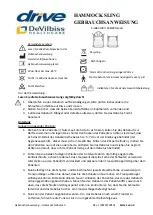
© Guldmann 01/2020 # 900640_1
© Guldmann 01/2020 # 900640_1
6
Lifting hanger
Caution!
Be careful when attaching the lifting sling on the hooks .
Check that the straps have been pulled completely through
the rubber safety catch (A) and into place in the lifting
hanger’s hooks . When pressing the up button to lift the user,
check again that all the straps remain correctly placed in the
lifting hanger’s hooks (fig. 1a and fig. 1b).
Fig . 1a
Fig . 1b
A
A
Placing the sling, look at page 27.
2 .00 Maintenance
2 .01 Cleaning
Do not wash
Do not use bleaching agent
Do not tumble dry
Do not iron
The sling is a disposable sling and if necessary it can be discard-
ed every time it has been used – or when the user is discharged.
2 .02 The owner’s daily maintenance duty
Check the lifting sling for wear and damage before use according
to the following checklist which is not intended to represent all
potential inspection steps. Potential damage may vary. Judgment
of inspector/site prevails.
Sling inspection checklist
Before using a Guldmann sling / accessory check the following:
Is the sling clean?
Follow facility specific infection control procedure.
Is the sling’s label present, legible and complete?
Missing, illegible or incomplete sling label(s) could make identi-
fication of appropriate size of the sling, function of sling, and or
weight limit capacity of the sling impossible.
Are the lifting straps and stitches intact?
• Look for broken or worn stitches
• Look for knots in straps
• Look for tears or fraying of straps
• Look for snags or punctures or holes
• Look for any particles in fabric or straps
Is the fabric intact?
• Look for abnormal wear patterns, excessive wear, abrasive
evidence
• Look for cuts or frayed fabric
•
Look for unusual or significant discoloration
• Look for snags, punctures, tears, holes
• Look for frayed or insecure seams
• Look for any acid / caustic / thermal burns
• Look for changes in material consistency, e.g. increased
stiffness
• Look for any imbedded particles
Has the shape of the sling been altered, made shorter or
longer in relation to the original size using knots, needles,
tape or other methods?
Conclusion
If the sling suffers from one or more of the above mentioned
conditions then it must be taken out of service regardless of the
weight of the person to be lifted.
2 .03 Disposal of slings
Slings are disposed of by incineration. By proper incineration
polyester will be degraded to carbon dioxide and water.
3 .00 Service and lifetime
3 .01 Safety/service inspections
In accordance with international standard EN/ISO 10535 “Hoist for
the transfer of disabled persons – Requirements and test meth-
ods” an inspection
must
be performed every 6-month according
to the following instructions, which is not intended to represent all
potential inspection steps. Potential damage may vary. Judgment
of inspector/site prevails.
Safe Operating Practices with Slings
Considerations for damaged or defective slings and taking them
out of service:
Withdraw the sling from service if one or more of the following
conditions are present:
• chemical or caustic burns
• melting or charring of any part of the sling
• snags, punctures, tears or cuts
• broken or worn stitches
• missing, illegible or incomplete sling tag
• knots in any part of the sling
• abrasion
• other visible damage that causes doubt as
to the strength of the sling
Sling inspection is done for the protection of the user, the caregiv-
er, and the overall hospital site safety. A sling inspection system
has additional benefit. Systematic sling inspection will assist in the
identification of damage trends, potentially leading to cost effective
suggestions and results. The inspection process can also help to
identify inventory duplicity in certain sling types and sizes.
Sling inspection system
Development of a specific procedure and program for the inspec
-
tion of slings at your facility is your best safeguard. Consider em-
ploying a three part system of inspection. Slings that are removed
from service and are not capable of repair should be disposed of
so they are unfit for any future use and can not find a way back
into active inventory.
1) Initial
This level of inspection is done at the time that the sling is re-
ceived into your facility. The inspector should ensure that no dam-
age has occurred during transit, and also verify that the sling work
load limits match those contained in the manufacturer’s catalogue.
If your facility documents the sling inspection process through writ-
ten inspection records, the paper trail should begin at this stage.
























